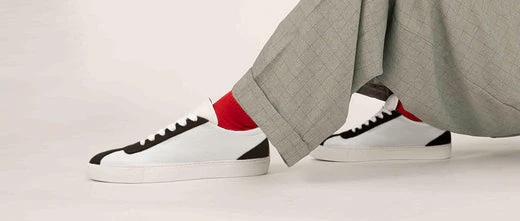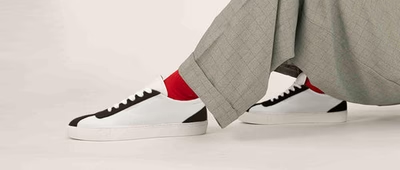How Do You Know if a Shoe Fits Properly? 5 Easy Tests


Table of Contents
- Introduction
- Understanding Shoe Sizing
- Test #1: The Toe Wiggle Test
- Test #2: The Heel Slip Test
- Test #3: The Width Test
- Test #4: The Arch Support Test
- Test #5: The Walk Around Test
- Signs of an Improper Shoe Fit
- When to Try a Different Size or Width
- Common Fit Myths Debunked
- Different Shoe Types, Different Fit Rules
- What to Do If You Can’t Find the Perfect Fit
- How to Shop for Shoes Online and Ensure a Good Fit
- Why Regularly Checking Shoe Fit is Important
- Conclusion
1. Introduction
Finding the perfect pair of shoes is about more than just style. The right fit can ensure both comfort and long-term foot health, while ill-fitting shoes can lead to a range of issues, from minor discomfort to more serious foot problems. Knowing how to check if a shoe fits properly can save you from blisters, sore feet, and even chronic conditions. In this guide, we’ll explore five simple tests to help you determine if your shoes are truly the perfect fit.
The Importance of Finding the Perfect Fit for Your Shoes
Wearing shoes that fit correctly can drastically improve your daily comfort. Whether you’re walking, running, or standing for long periods, the right shoe supports your foot in all the right places. Beyond comfort, a well-fitted shoe helps maintain proper alignment and posture, reducing strain on your knees, hips, and back.
How Poorly Fitting Shoes Can Affect Your Health and Comfort
Shoes that are too tight can compress your toes, leading to painful problems like bunions and corns. Too loose, and your feet slide around, causing blisters and instability. Over time, wearing poorly fitting shoes can contribute to chronic pain, misalignment of the body, and even long-term joint issues.
2. Understanding Shoe Sizing
Why Shoe Size Isn’t Always Consistent Between Brands
Shoe sizes can vary significantly between brands, meaning that your size in one brand might not fit the same in another. This discrepancy occurs because different manufacturers follow their own sizing standards. As a result, you should always try on shoes or consult size guides when switching brands.
How to Measure Your Feet for Accurate Sizing
To get the most accurate sizing, measure your feet at the end of the day when they are slightly swollen. Use a ruler or a Brannock device (available in most shoe stores) to measure both the length and width of your feet. It’s important to measure both feet, as one is usually slightly larger than the other. Always choose shoes based on the larger foot.
3. Test #1: The Toe Wiggle Test
How Much Room Should Be in the Toe Box?
The toe box is the part of the shoe that covers your toes. You should have enough room to wiggle your toes without them feeling cramped. Ideally, there should be about half an inch of space between your longest toe and the front of the shoe.
Why Your Toes Need Space to Move
Toes need space to flex naturally while walking. If the toe box is too tight, it can lead to issues like blisters, toenail damage, and even deformities like hammertoes. Shoes with enough toe room help your feet function more naturally and prevent painful conditions.
Common Mistakes When Checking the Toe Box Fit
One common mistake is assuming that the shoe will "stretch out" over time. While some shoes do break in slightly, they rarely stretch enough to fix a cramped toe box. It’s always best to choose shoes that fit well right from the start.
4. Test #2: The Heel Slip Test
What is Heel Slippage and Why Does It Happen?
Heel slippage occurs when your heel lifts too much inside the shoe as you walk. It’s often a sign that the shoe is too big or doesn’t have the right shape for your foot. While some minor slippage can be normal, excessive movement will lead to blisters and instability.
How to Perform the Heel Slip Test Correctly
To check for heel slippage, walk around in the shoes and notice how much your heel lifts. If your heel moves up and down more than about half an inch with each step, the shoe is likely too large. A well-fitted shoe will keep your heel securely in place.
What Heel Slippage Tells You About the Fit
If your heel slips, it indicates that the shoe isn’t offering proper support at the back. This can affect your overall stability and comfort, making it harder to walk naturally.
5. Test #3: The Width Test
How to Determine if a Shoe is Too Tight or Too Loose
The width of the shoe is just as important as the length. Shoes that are too narrow will squeeze your feet, while shoes that are too wide will cause your foot to slide around. Both scenarios can lead to discomfort and even injury.
How to Check for Proper Width Without Pinching or Gapping
When standing in the shoe, your foot should feel snug but not squeezed. There should be no noticeable pinching or pressure on the sides, nor should there be gaps. The shoe should support the width of your foot without any areas of discomfort.
Signs Your Shoe Width is Incorrect and What to Do About It
If you feel pinching along the sides or if the shoe leaves marks on your feet, it’s too narrow. On the other hand, if your foot shifts from side to side as you walk, the shoe is too wide. Choosing shoes in a wider or narrower width can often resolve these issues.
6. Test #4: The Arch Support Test
Understanding Different Types of Arches (Flat, High, Neutral)
Your foot’s arch plays a crucial role in how shoes fit. Flat feet need more support to prevent overpronation, while high arches require cushioning to avoid putting too much pressure on the heel and ball of the foot.
How to Test for Adequate Arch Support in Your Shoe
To test for arch support, stand in the shoes and pay attention to how the midsole feels. The arch of the shoe should comfortably match the curve of your foot. You should feel supported without excessive pressure.
Why Arch Support is Critical for Long-Term Comfort
Proper arch support helps distribute your body weight evenly across your feet. Shoes that lack adequate arch support can lead to pain in your feet, knees, hips, and lower back, especially if you’re on your feet for long periods.
7. Test #5: The Walk Around Test
Why Walking in the Shoe is the Ultimate Fit Test
The best way to know if a shoe fits properly is to walk in it. Walking allows you to feel how the shoe moves with your foot, revealing any pressure points or areas of discomfort. A good shoe should feel comfortable and stable right from the first few steps.
What to Look For While Walking: Comfort, Stability, and Pressure Points
As you walk, focus on how the shoe feels in key areas: the toe box, heel, arch, and sides. Look for any slipping, pinching, or discomfort. Pay attention to whether the shoe feels stable and provides support throughout your stride.
How to Know if the Shoe Will Break In or Stay Uncomfortable
While some shoes may soften slightly with wear, they should never cause pain from the outset. If you notice discomfort during the walk-around test, it’s unlikely that the shoe will become significantly more comfortable over time.
8. Signs of an Improper Shoe Fit
Blisters, Calluses, and Other Warning Signs
Blisters, calluses, or red marks are all signs that your shoes aren’t fitting correctly. These issues arise from friction or pressure points caused by a poor fit, and they will only get worse if not addressed.
How to Spot Subtle Fit Issues Before It’s Too Late
Even if a shoe feels okay initially, subtle signs like slight rubbing or pressure can indicate future problems. If a shoe feels even slightly uncomfortable during the try-on process, it’s best to consider a different size or style.
9. When to Try a Different Size or Width
How to Know if You Need a Different Size, Width, or Style
If any part of the shoe feels too tight, loose, or uncomfortable, don’t hesitate to try a different size or width. Sometimes, even going up or down a half size can make a huge difference in overall comfort.
Why Half Sizes Matter: The Case for Trying Multiple Options
Many people’s feet fall between standard sizes. Trying half sizes can often help you find the perfect balance between too tight and too loose. Don’t be afraid to experiment with different options until you find the best fit.
10. Common Fit Myths Debunked
Why a Shoe Shouldn’t Need to Break In to Feel Comfortable
A common misconception is that shoes will "break in" over time. While they may soften slightly, shoes that are uncomfortable from the start are unlikely to feel much better later on.
The Myth of “One Size Fits All” Foot Shapes
There’s no such thing as a “one size fits all” shoe. Feet come in various shapes and sizes, and what works for one person might not work for another. Always prioritize finding a shoe that fits your unique foot shape.
11. Different Shoe Types, Different Fit Rules
Why Athletic Shoes Have Different Fit Considerations
Athletic shoes are designed with specific activities in mind, so they need to fit differently than casual or dress shoes. Running shoes, for example, often provide more cushioning and flexibility, while hiking shoes prioritize support and durability.
How Dress Shoes and Casual Shoes Vary in Fit
Dress shoes tend to have a more structured fit and may feel tighter than casual shoes. It’s important to ensure that dress shoes are comfortable from the start, as they won’t stretch as much as casual footwear.
12. What to Do If You Can’t Find the Perfect Fit
Insoles, Inserts, and Orthotics: How to Adjust for Fit Issues
If you can’t find the perfect fit, using insoles or custom orthotics can help. These can provide extra arch support, cushioning, or adjust for minor fit issues, making your shoes more comfortable.
Customizing Shoes: When It’s Worth the Investment
For those with unique foot shapes or ongoing foot problems, customizing shoes can be a worthwhile investment. Custom shoes are tailored to your feet, offering unmatched comfort and support.
13. How to Shop for Shoes Online and Ensure a Good Fit
Tips for Reading Size Charts and Reviews
When shopping online, use size charts to determine your best fit. Pay attention to customer reviews to see if others mention sizing up or down, as this can provide valuable insight into how a particular shoe fits.
The Importance of Knowing Your Return and Exchange Options
Since finding the right fit can be tricky online, always check the retailer’s return or exchange policy. This allows you to return or swap shoes if they don’t fit as expected.
14. Why Regularly Checking Shoe Fit is Important
How Feet Can Change Over Time (Pregnancy, Age, Weight)
Your feet can change due to various factors, including age, weight gain, and pregnancy. Regularly checking your shoe size ensures you are always wearing footwear that accommodates your current foot shape.
When to Replace Shoes Even If They Still Fit
Even if shoes fit well, their cushioning and support can wear out over time. Replace shoes that show signs of significant wear to maintain proper foot health.
15. Conclusion
To ensure your shoes fit perfectly, remember to perform the Toe Wiggle, Heel Slip, Width, Arch Support, and Walk Around tests. Each test offers insight into crucial aspects of comfort and fit.












